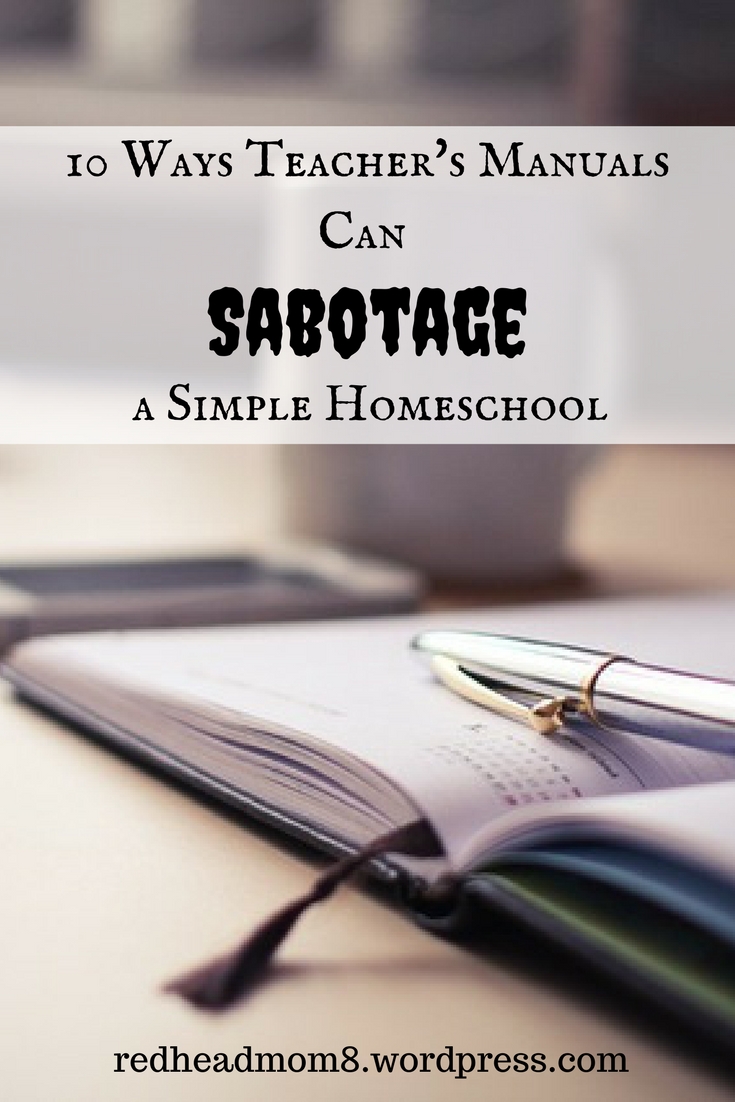Homeschool moms can be pretty hard on themselves. I can’t even count how many times in the past few months I’ve interacted with people who are doing their absolute best when it comes to educating their children but feel like they’re failing them miserably.
There are a variety of reasons why they feel this way, but, by far, the biggest culprit seems to be their curriculum. (For more on this subject, watch this video.)
Why?
Two words. Teacher’s manuals.
I know lots of people swear by them. In fact, the other day, I overheard someone say that a good teacher’s manual can make homeschooling so much easier. For a minute, I wondered if I was developing a hearing problem. How can anyone think they make things easier?!
Look, I know that homeschooling works differently for everyone, and some people may, indeed, think these manuals are a godsend, but in my own experience and the experience of many homeschoolers I’ve advised, they can be a real problem. Here’s why.
10 Reasons Not to Use or Buy Teacher’s Manuals in a Simple Homeschool
1. They make things more complicated than they have to be.

Way back when I was a newbie homeschooler, I bought some math and phonics curriculum for my young children. I purchased the teacher’s manuals separately. These workbooks were great resources- so great, in fact, that I still use them 7 years later. They were simple, to-the-point, and offered just enough questions/problems without going overboard.
And then came the teacher’s guides. Oh. my. word. What could have easily been quick and effective lessons turned into marathon homeschool days for my 6 yr old.
Instead of just having my daughter trace the letters and say the sounds in her phonics book, I had to cut out flash cards, turn to page 37 (or some other random page) of a different book, narrate a scripted lesson, and then move on to a leveled reader.
Phew.
As for math, according to the teacher’s manual, it wasn’t enough for my kindergartner to complete the 20 problems on the page. They recommended two pages per day, plus various hands-on activities with math manipulatives. And let’s not forget the additional scripted lessons. Now, I’m all for math manipulatives, but I usually use them with a decently-sized lesson- not separately- or I use them as a stand-alone lesson.
Thankfully, I had enough sense to ditch the manuals after awhile, but I know there are a lot of moms out there who just can’t bring themselves to do it, so my advice is: Don’t buy them in the first place!
2. The “suggested schedules” are unrealistic.

Have you ever noticed how curriculums are usually based on a 36 week schedule? Not only that, most of them break things down day-by-day. For the new homeschooler, this may look great. They might even be relieved at having instructions to follow. Unfortunately, these schedules don’t account for illnesses, field trips, breaks, and anything else that happens in the midst of real life.
Some people are okay with adjusting things, but recently I’ve communicated with so many homeschool moms who feel like they’re doing something wrong if they get off schedule.
As if that weren’t enough, a good portion of curriculums expect you to complete an impractical amount of activities each and everyday. I mean, really. Who has time to read 20 pages of a textbook, write a synopsis, construct a diorama, and watch an instructional DVD for one subject in one day? (I’m being facetious, but this is what it can feel like!)
Even my beloved KONOS comes with lesson plans that seem ridiculous to me. At first, I drove myself crazy trying to stick to them. Eventually, I threw the schedule out the window and did my own thing because I knew that if I kept it up, I’d ditch the curriculum altrogether, and I really didn’t want to do that.
3. They’re structured too much like school.

I don’t know what it is with most curriculum companies. They make money off of our right to teach our kids in ways that are more effective than school, and then they turn around and create products they expect to be used just like a school would.
It doesn’t make sense. If I wanted my kids to learn in a school setting, I’d send them to school.
4. It’s easy to get caught up in sticking to the schedule.

I’ve noticed that many teacher’s manuals come with time schedules. I guess these can be okay for giving you an idea of how to do things, but, to be honest, they’re usually too long and, again, are too schoolish.
It’s so important to fashion a schedule that fits your family. Don’t try to replicate the one in your teacher’s guide. And remember, life happens in the midst of your homeschool year. Don’t get caught up in obsessing over staying on schedule. There are too many other things you’re bound to miss out on.
5. They make it harder to add your own flavor.

Curriculums should be used as a framework, and nothing more. No one knows your children better than you do. Forget how the teacher’s manual tells you how to teach. Present the material in a way that is exciting for them to learn and you to teach. Believe me, that won’t happen if you robotically do what the instruction book tells you to.
6. They can give the impression that there’s only one right way to use the curriculum.

Seasoned homeschoolers know that there are thousands of ways to approach any given curriculum. This wisdom may not come too easily to someone new to the scene. The lesson plans in your teacher’s manual are merely suggestions. Your curriculum is a tool, not a Bible.
7. They actually make it take longer to plan.

Going back to the comment in the beginning of the post claiming that teacher’s manuals make lesson planning easier, all I can say is, not in my experience! Since they’re so complicated and expect so much to be done per lesson, preparation can be an utter nightmare. What’s easier? Doing your own thing in an uncomplicated manner, or running around making sure you have everything you need for every single child for every single curriculum? Sounds to me like a recipe for burnout! (I actually tackled homeschool burnout in this video.
8. You run the risk of falling back into the schoolish mindset.

One of the first things a new homeschooling family should do is deschool. (Incidentally, I have a video about that, too!) For someone coming from a long history with public education, this can be a rather lengthy process. Exposing yourself to the schoolish approaches so often used in these manuals (after deschooling) can get you right back where you started again- believing that education has to look like school. It doesn’t.
9. They don’t allow for a child’s individual abilities.

The lesson plans included in these manuals are written for a generic audience. They’re created with “the average student” in mind. What’s glaringly obvious- or should be- is that not every child learns the same way as others. What happens to those children who need three days for one math lesson, instead of one? Or to the child who requires a full month to learn a phonics lesson meant to take a week? Should they be rushed through it? Pushed? Or should that schedule be adjusted to fit the child?
Regrettably, I’m afraid it’s the child that too often is expected to adjust to the schedule, instead of the other way around.
10. They don’t allow for a child’s individual limits.

Just because a teacher’s manual says that your child should be able to complete 50 math problems a day doesn’t mean that they really can- or should. Every child has limits. Seriously. Don’t put unrealistic expectations on a child who can sit for 10 minutes, at best, just because the curriculum says so. Your child deserves more than that.
As homeschoolers, we’re extremely blessed with the abundance of resources we can choose from. I hope I’ve convinced you that teacher’s manuals aren’t mandatory. Don’t waste your money. They’re just not worth it. Instead, use what you know about your children and yourself to utilize those resources in a manner that best suits you. There is no manual in existence that can accomplish that.
So why bother trying?
(For a related video on relying too much on your curriculum click here!)



I’ve had two experiences with teacher’s manuals and they both drove me nuts until I ditched them. I especially relate to #5 and #9. Fortunately, I have a rebellious nature that pushes me to do some things, such as homeschooling, “my way”. 😅
LikeLiked by 1 person
Lol. I think I’ve developed a similar nature. 😉
LikeLiked by 1 person
Guess what? Public school teachers RARELY even look at the manual much, if at all. LOL. I know- I used to be one! But yeah, starting out with homeschooling I got wrapped up in those manuals too! WHY??? #8 is exactly right on (as they all are)– the manual just takes all the flexibility away. Sometimes there’s good materials out there if we use them in accordance to what works for US…and seldom will any publisher know how it will work well for US.
LikeLiked by 1 person
That is absolutely right. I think far too many fall into the trap of thinking they HAVE to use them.
LikeLiked by 1 person
I just tried to convince a mom today that just because they were provided with 50 practice math problems on the page, they didn’t have to DO all 50!! And then another mom chimed in and said she just now felt free enough to pick and choose what she does with her teachers manuals!
LikeLiked by 1 person
My best advice for what to do with teacher’s manuals is toss them in the trash. 😉
LikeLike
YES YES AND YES!! Love this so much!
LikeLiked by 1 person
🙂
LikeLike
A very good reminder.
Blessings, Dawn
LikeLiked by 1 person
Reading this has redeemed how I’ve been feeling (like an utter failure) about our entire two years of this journey. My teachers guides, and even my own thoughtfully-selected planner I bought, have left me continuously feeling overwhelmed and underachieving, as I had to accommodate LIFE and the kids’ individual paces and needs. At the end of each month, becoming panicked at being “behind.” This post has shown me that slow and steady, the way I’ve BEEN doing it, will still win in the end. I can’t thank you enough for this! I have tears of relief!
LikeLiked by 1 person
I am so, so glad to hear that. My whole purpose for writing this blog is to encourage people, so I’ve gotta say…you made my day!
LikeLike
Great post! Teacher’s manuals give new homeschool moms, who are unsure of themselves, a good jumping off point. But you’re so right that once we are past that stage, we should feel free to fling them off and experience homeschool freedom. 🙂
LikeLiked by 1 person
Absolutely!
LikeLike
Yes! All of these apply in the classroom, too. When I was teaching we’d have trainings about teaching directly from the manual – how long it “should” take, what order to teach, etc. Then we would all leave and go back into the classroom, put down the manual, and teach the children!
LikeLiked by 1 person
And that’s just as it should be! 🙂
LikeLiked by 1 person
Even when I taught in traditional school, I “tweaked” the manuals quite a bit. 🙂
LikeLiked by 1 person
On the other hand I wish I had one for the 60+ year old LAtin book we’re about to start, hah! I used the same book myself in school but that was 1995-1996 and teaching it is a different matter. Firtunately I am in contact with the good lady who taught me.
LikeLiked by 1 person
Well, that worked out, didn’t it? 😉
LikeLike